A New Solution for City Distribution to Achieve Environmental Benefits within the Trend of Green Logistics: A Case Study in China
Abstract
:1. Introduction
2. Literature Review
3. Proposal of New Distribution Mode
4. Model Development
4.1. Node Importance Evaluation within the Trend of Green Logistics
4.1.1. Node Importance Indices
4.1.2. Weights for the Indices
4.2. Location Model for ECSSs
- (1)
- Assumptions
- i.
- The capacity of each candidate DO can serve the delivery demands of EPs.
- ii.
- Each IEC will be fully occupied, and there is no extra space for more express deliveries.
- iii.
- All the express deliveries in each IEC will be picked up by the end customers on the same day.
- iv.
- The delivery demand of each EP is evenly satisfied by each express enterprise.
- v.
- If an IEC serves w EPs, the IEC provides 1/w of the capacity for each EP.
- vi.
- The delivery efficiency of all the couriers in the end network is the same.
- vii.
- Each EP and IEC should be served by only one ECSS in the end crowdsourcing distribution network.
- (2)
- Indices and parameters
- i is the index for end DOs,
- j is the index for end EPs,
- k is the index for end IECs,
- n is the number of DOs
- m is the number of EPs
- p is the number of IECs
- is the average daily delivery demand of EP j
- is the number of IECs serving EP j
- is the number EPs served by IEC k
- is the distance from DO i to EP j
- is the distance from DO i to IEC k
- is the distribution relationship between IEC k and EP j
- Q is the capacity of IECs
- D is the maximum delivery quantity the courier can handle from DOs to EPs in a batch
- z is the number of DOs selected to be ECSSs by decision maker
- (3)
- Decisions variables
- : 1 if DO i is selected to be ECSS; 0 otherwise
- : 1 if EP j is served by DO i; 0 otherwise
- : 1 if IEC k is served by DO i; 0 otherwise
- (4)
- Objective function
- (5)
- Constraints
5. Empirical Study
5.1. Background and Data
5.2. Results and Discussion
5.2.1. Location of ECSSs
5.2.2. Environmental Benefits of the New Mode
For the End of the Distribution
For the Front-End of the Distribution
For the Entire Distribution
5.2.3. Suggestions
6. Conclusions
Author Contributions
Funding
Conflicts of Interest
References
- China Internet Network Information Center. The 45th Statistical Report on Internet Development in China. 2020. Available online: http://www.cnnic.net.cn/hlwfzyj/hlwxzbg/hlwtjbg/202004/t20200428_70974.html (accessed on 28 April 2020).
- Gan, M.; Yang, S.; Li, D.D.; Wang, M.; Chen, S.; Xie, R.; Liu, J. A novel intensive distribution logistics network design and profit allocation problem considering sharing economy. Complexity 2018. [Google Scholar] [CrossRef] [Green Version]
- Wang, X.P.; Zhan, L.M.; Ruan, J.H.; Zhang, J. How to choose “last mile” delivery modes for e-fulfillment. Math. Probl. 2014. [Google Scholar] [CrossRef]
- State Post of Bureau of The People’s Republic of China. State Post of Bureau Announced the Operation of Postal Industry in 2019. 2020. Available online: http://www.spb.gov.cn/xw/dtxx_15079/202001/t20200114_2005598.html (accessed on 14 January 2020).
- Zhang, W.; Zhang, M.Y.; Zhang, W.Y.; Zhou, Q.; Zhang, X. What influences the effectiveness of green logistics policies? A grounded theory analysis. Sci. Total. Environ. 2020. [Google Scholar] [CrossRef]
- Srivastava, S.K. Green supply-chain management: A state-of-the-art literature review. Int. J. Manag. Rev. 2007, 9, 53–80. [Google Scholar] [CrossRef]
- Khan, S.A.R.; Dong, Q.L. Does national scale economic and environmental indicators spur logistics performance? Evidence from UK. Environ. Sci. Pollut. Res. 2017, 24, 26692–26705. [Google Scholar] [CrossRef]
- Brown, J.R.; Guiffrida, A.L. Carbon emissions comparison of last mile delivery versus customer pickup. Int. J. Logist-Res. App. 2014, 17, 503–521. [Google Scholar] [CrossRef]
- Aized, T.; Srai, J.S. Hierarchical modelling of last mile logistic distribution system. Int. J. Adv. Manuf. 2014, 70, 1053–1061. [Google Scholar] [CrossRef]
- Devari, A.; Nikolaev, A.G.; He, Q. Crowdsourcing the last mile delivery of online orders by exploiting the social networks of retail store customers. Transport. Res. E-Log. 2017, 105, 105–122. [Google Scholar] [CrossRef]
- Ranieri, L.; Digiesi, S.; Silvestri, B.; Roccotelli, M. A review of last mile logistics innovations in an externalities cost reduction vision. Sustainability. 2018, 10, 782. [Google Scholar] [CrossRef] [Green Version]
- Ji, S.F.; Luo, R.J.; Peng, X.S. A probability guided evolutionary algorithm for multi-objective green express cabinet assignment in urban last-mile logistics. Int. J. Prod. Res. 2019, 57, 3382–3404. [Google Scholar] [CrossRef]
- Shouket, B.; Zaman, K.; Nassani, A.A.; Aldakhil, A.M.; Abro, M.M.Q. Management of green transportation: An evidence-based approach. Environ. Sci. Pollut. Res. 2019, 26, 12574–12589. [Google Scholar] [CrossRef] [PubMed]
- Talbi, B. CO2 emissions reduction in road transport sector in Tunisia. Renew. Sust. Energ. Rev. 2017, 69, 232–238. [Google Scholar] [CrossRef]
- Alshehry, A.S.; Belloumi, M. Study of the environmental Kuznets curve for transport carbon dioxide emissions in Saudi Arabia. Renew. Sust. Energ. Rev. 2017, 75, 1339–1347. [Google Scholar] [CrossRef]
- Khan, S.A.R. The nexus between carbon emissions, poverty, economic growth, and logistics operations-empirical evidence from southeast Asian countries. Environ. Sci. Pollut. Res. 2019, 26, 13210–13220. [Google Scholar] [CrossRef] [PubMed]
- Bi, K.X.; Yang, M.K.; Zhou, X.G.; Zahid, L.; Zhu, Y.; Sun, Z. Reducing carbon emissions from collaborative distribution: A case study of urban express in China. Environ. Sci. Pollut. R. 2020, 27, 16215–16230. [Google Scholar] [CrossRef] [PubMed]
- Guo, X.P.; Ren, D.F.; Shi, J.X. Carbon emissions, logistics volume and GDP in China: Empirical analysis based on panel data model. Environ. Sci. Pollut. Res. 2016, 23, 24758–24767. [Google Scholar] [CrossRef] [PubMed]
- Baloch, M.A.; Suad, S. Modeling the impact of transport energy consumption on CO2 emission in Pakistan: Evidence from ARDL approach. Environ. Sci. Pollut. Res. 2018, 25, 9461–9473. [Google Scholar] [CrossRef]
- Zhang, Z.; Figliozzi, M.A. A survey of China’s logistics industry and the impacts of transport delays on importers and exporters. Transp. Rev. 2010, 30, 179–194. [Google Scholar] [CrossRef]
- Leitner, R.; Meizer, F.; Prochazka, M.; Shin, W. Structural concepts for horizontal cooperation to increase efficiency in logistics. CIRP. J. Manuf. Sci. Tec. 2014, 4, 332–337. [Google Scholar] [CrossRef]
- Deutsch, Y.; Golany, B. A parcel locker network as a solution to the logistics last mile problem. Int. J. Prod. Res. 2018, 56, 251–261. [Google Scholar] [CrossRef]
- Fan, W.; Xu, M.; Dong, X.; Wei, H. Considerable environmental impact of the rapid development of China’s express delivery industry. Resour. Conserv. Recycl. 2017, 126, 174–176. [Google Scholar] [CrossRef]
- Montoya-Torres, J.R.; Munoz-Villamizar, A.; Vega-Mejia, C.A. On the impact of collaborative strategies for goods delivery in city logistics. Prod. Plan. & Control 2016, 27, 443–455. [Google Scholar]
- Guo, J.; Ma, S. Environmental impact assessment for city logistics distribution systems. Environ. Eng. Res. 2017, 22, 363–368. [Google Scholar] [CrossRef] [Green Version]
- Rai, H.B.; Verlinde, S.; Macharis, C. Shipping outside the box. Environmental impact and stakeholder analysis of a crowd logistics platform in Belgium. J. Clean. Prod. 2018, 202, 806–816. [Google Scholar]
- Serafini, S.; Nigro, M.; Gatta, V.; Marcucci, E. Sustainable crowdshipping using public transport: A case study evaluation in Rome. Transp. Res. Procedia. 2018, 30, 101–110. [Google Scholar] [CrossRef]
- Giret, A.; Carrascosa, C.; Julian, V.; Rebollo, M.; Botti, V. A crowdsourcing approach for sustainable last mile delivery. Sustainability. 2018, 10, 4563. [Google Scholar] [CrossRef] [Green Version]
- Kafle, N.; Zou, B.; Lin, J. Design and modeling of a crowdsource-enabled system for urban parcel relay and delivery. Transport. Res. B-Meth. 2017, 99, 62–82. [Google Scholar] [CrossRef]
- Paloheimo, H.; Lettenmeier, M.; Waris, H. Transport reduction by crowdsourced deliveries - a library case in Finland. J. Clean. Prod. 2016, 132, 240–251. [Google Scholar] [CrossRef]
- Binetti, M.; Caggiani, L.; Camporeale, R.; Ottomanelli, M. A sustainable crowdsourced delivery system to foster free-floating bike-sharing. Sustainability. 2019, 11, 2772. [Google Scholar] [CrossRef] [Green Version]
- Arslan, A.M.; Agatz, N.; Kroon, L.; Zuidwijk, R. Crowdsourced delivery—A dynamic pickup and delivery problem with ad hoc drivers. Transp. Sci. 2019, 53, 222–235. [Google Scholar] [CrossRef] [Green Version]
- Rai, H.B.; Verlinde, S.; Merckx, J.; Macharis, C. Crowd logistics: An opportunity for more sustainable urban freight transport. Eur. Transp. Res. Rev. 2017, 9, 39. [Google Scholar]
- Mehmann, J.; Frehe, V.; Teuteberg, F. Crowd logistics-a literature review and maturity model. In Proceedings of the Hamburg International Conference of Logistics (HICL), Hamburg, Germany, September 2015. [Google Scholar]
- Wang, J.X.; Lim, M.K.; Tseng, M.L.; Yang, Y. Promoting low carbon agenda in the urban logistics network distribution system. J. Clean. Prod. 2019, 211, 146–160. [Google Scholar] [CrossRef]
- Wang, X. Study on relationship between green logistics activity and logistics performance. Cluster. Comput. 2019, 22, S6579–S6588. [Google Scholar] [CrossRef]
- Sun, Q. Empirical research on coordination evaluation and sustainable development mechanism of regional logistics and new-type urbanization: A panel data analysis from 2000 to 2015 for Liaoning Province in China. Environ. Sci. Pollut. Res. 2017, 24, 14163–14175. [Google Scholar] [CrossRef] [PubMed]
- Kucukoglu, I.; Ene, S.; Aksoy, A.; Öztürk, N. A memory structure adapted simulated annealing algorithm for a green vehicle routing problem. Environ. Sci. Pollut. Res. 2015, 22, 3279–3297. [Google Scholar] [CrossRef]
- Wang, Y.; Zhang, D.X.; Liu, Q.; Shen, F.; Lee, L.H. Towards enhancing the last-mile delivery: An effective crowd-tasking model with scalable solutions. Transport. Res. E-Log. 2016, 93, 279–293. [Google Scholar] [CrossRef]
- Lee, S.; Kang, Y.; Prabhu, V.V. Smart logistics: Distributed control of green crowdsourced parcel services. Int. J. Prod. Res. 2016, 54, 6956–6968. [Google Scholar] [CrossRef]
- Yang, H.; Nie, Y.C.; Zhang, H.B.; Di, Z.R.; Fan, Y. Insight to the express transport network. Comput. Phys. Commun. 2009, 180, 1511–1515. [Google Scholar] [CrossRef]
- Conde, L.E.S.; Used, J.; Romance, M. Optimal distributions for multiplex logistic networks. Chaos. 2016, 26, 065312. [Google Scholar] [CrossRef]
- Wu, Y.N.; Ma, H. Logistics network nodes importance analysis based on the complex network theory. In Proceedings of the 2nd International Conference on Measurement, Instrumentation and Automation (ICMIA 2013), Guilin, China, 23–24 April 2013. [Google Scholar]
- Zhao, L.J.; Li, H.Y.; Li, M.C.; Sun, Y.; Hu, Q.; Mao, S.; Li, J.; Xue, J. Location selection of intra-city distribution hubs in the metro-integrated logistics system. Tunn. Uudergr. Sp. Tech. 2018, 80, 246–256. [Google Scholar] [CrossRef]
- Zhou, M.R.; Duan, Y.T.; Yang, W.; Pan, Y.C.; Zhou, M. Capacitated multi-modal network flow models for minimizing total operational cost and CO2e emission. Comput. Ind. Eng. 2018, 126, 361–377. [Google Scholar] [CrossRef]
- Bader, D.A.; Kintali, S.; Madduri, K.; Mihail, M. Approximating betweenness centrality. In Lecture Notes in Computer Science (including Subseries Lecture Notes in Artificial Intelligence and Lecture Notes in Bioinformatics); Springer: Berlin/Heidelberg, Germany, 2007. [Google Scholar]
- Carmi, S.; Havlin, S.; Kirkpatrick, S.; Shavitt, Y.; Shir, E. A model of Internet topology using k-shell decomposition. Proc. Natl. Acad. Sci. USA 2007, 104, 11150–11154. [Google Scholar] [CrossRef] [PubMed] [Green Version]
- Kitsak, M.; Gallos, L.K.; Havlin, S.; Liljeros, F.; Muchnik, L.; Stanley, H.E.; Makse, H.A. Identification of influential spreaders in complex networks. Nat. Phys. 2010, 6, 888–893. [Google Scholar] [CrossRef] [Green Version]
- Liu, Z.; Jiang, C.; Wang, J.; Yu, H. The node importance in actual complex networks based on a multi-attribute ranking method. Knowl-Based. Syst. 2015, 84, 56–66. [Google Scholar] [CrossRef]
- Wang, X.J.; Chan, H.K. A hierarchical fuzzy TOPSIS approach to assess improvement areas when implementing green supply chain initiatives. Int. J. Prod. Res. 2013, 51, 3117–3130. [Google Scholar] [CrossRef]
- Skibniewski, M.J.; Chao, L.C. Evaluation of Advanced Construction Technology with AHP Method. J. Constr. Eng. M. 1992, 118, 577–593. [Google Scholar] [CrossRef]
- Wang, L.C.; Song, Y.P.; Feng, S. Lectotype optimization of offshore platforms by use of three-scale fuzzy analytical hierarchy process. China. Ocean. Eng. 2001, 15, 153–164. [Google Scholar]
- Vaidya, O.S.; Kumar, S. Analytic hierarchy process: An overview of applications. Eur. J. Oper. Res. 2006, 169, 1–29. [Google Scholar] [CrossRef]
- Dong, Y.C.; Jiang, A.M.; Zou, P.Z.; Ni, J. Application of three-scale AHP-TOPSIS evaluation model in green degree comparison of construction scheme. J. Water. Res. Plan. & Archit. Eng. 2019, 17, 194–199. [Google Scholar]
- Yoon, K.; Hwang, C.L. Multiple attribute decision making: An introduction. Eur. J. Oper. Res. 1995, 4, 287–288. [Google Scholar]
- Hsueh, J.T.; Lin, C.Y. Integrating the AHP and TOPSIS decision processes for evaluating the optimal collection strategy in reverse logistic for the TPI. Int. J. Green. Energy. 2017, 14, 1209–1220. [Google Scholar] [CrossRef]
- Jovcic, S.; Prusa, P.; Dobrodolac, M.; Svadlenka, L. A proposal for a decision-making tool in third-party logistics (3PL) provider selection based on multi-criteria analysis and the fuzzy approach. Sustainability 2019, 11, 4236. [Google Scholar] [CrossRef] [Green Version]
- Xu, Y.J.; Jia, H.F.; Zhang, Y.K.; Tian, G.D. Analysis on the location of green logistics park based on heuristic algorithm. Adv. Mech. Eng. 2018. [Google Scholar] [CrossRef]
- Beijing Municipal Postal Administration. Beijing Municipal Postal Administration Announced the Operation of the Whole City’s Postal Industry in December 2019. 2020. Available online: http://bj.spb.gov.cn/xytj_14733/tjxx_14735/202001/t20200115_2006141.html (accessed on 15 January 2020).
- Beijing Municipal Bureau of Statistics. Bulletin of National Economic and Social Development Statistics of Beijing in 2019. 2020. Available online: http://tjj.beijing.gov.cn/zxfbu/202003/t20200302_1673397.html (accessed on 2 March 2020).
- Zhang, K.Y.; Liu, X.M.; Yao, J.M. Identifying the driving forces of CO2 emissions of China’s transport sector from temporal and spatial decomposition perspectives. Environ. Sci. Pollut. Res. 2019, 26, 17383–17406. [Google Scholar] [CrossRef] [PubMed]
- Ubeda, S.; Arcelus, F.J.; Faulin, J. Green logistics at Eroski: A case study. Int. J. Prod. Econ. 2011, 131, 44–51. [Google Scholar] [CrossRef]

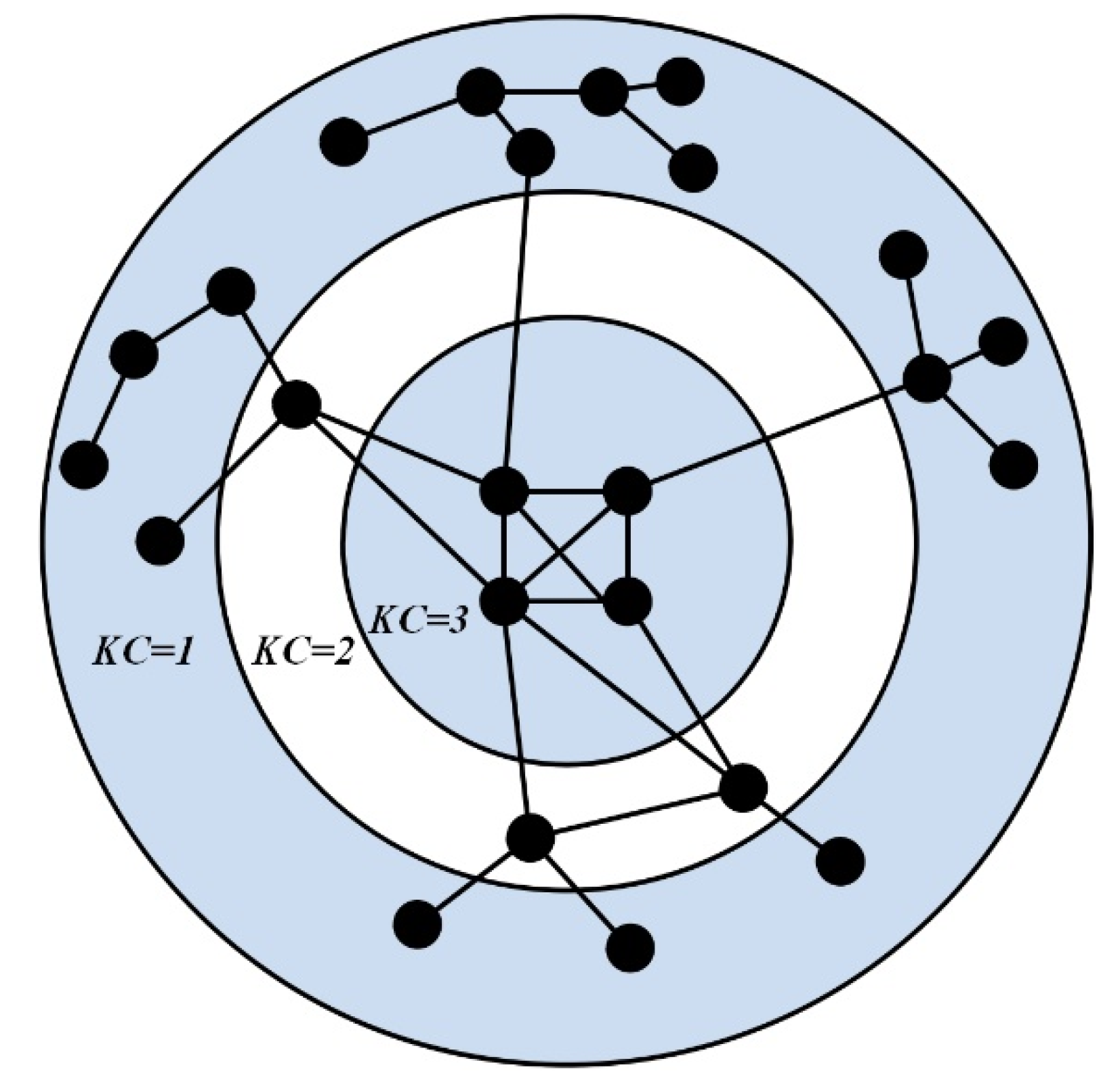


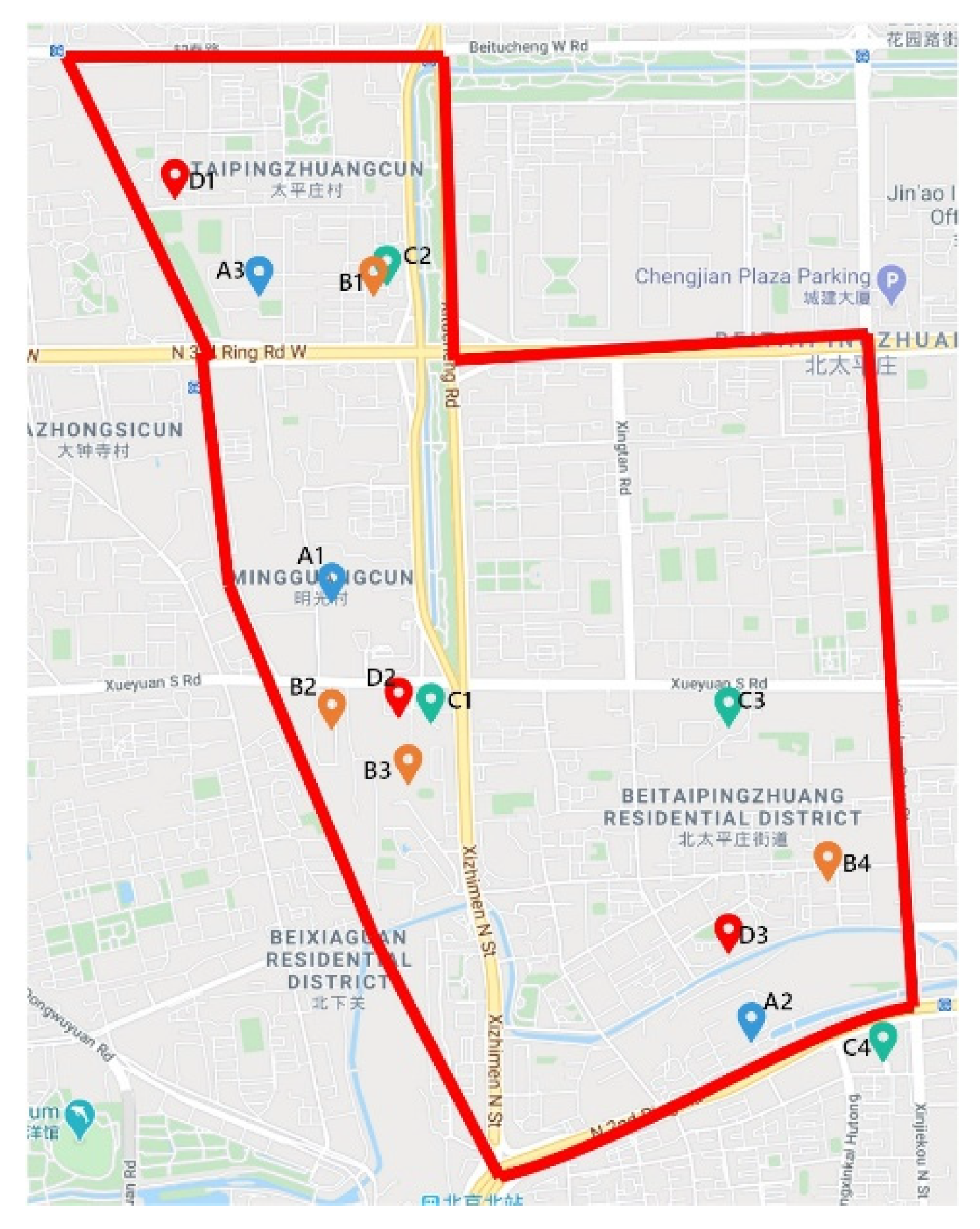
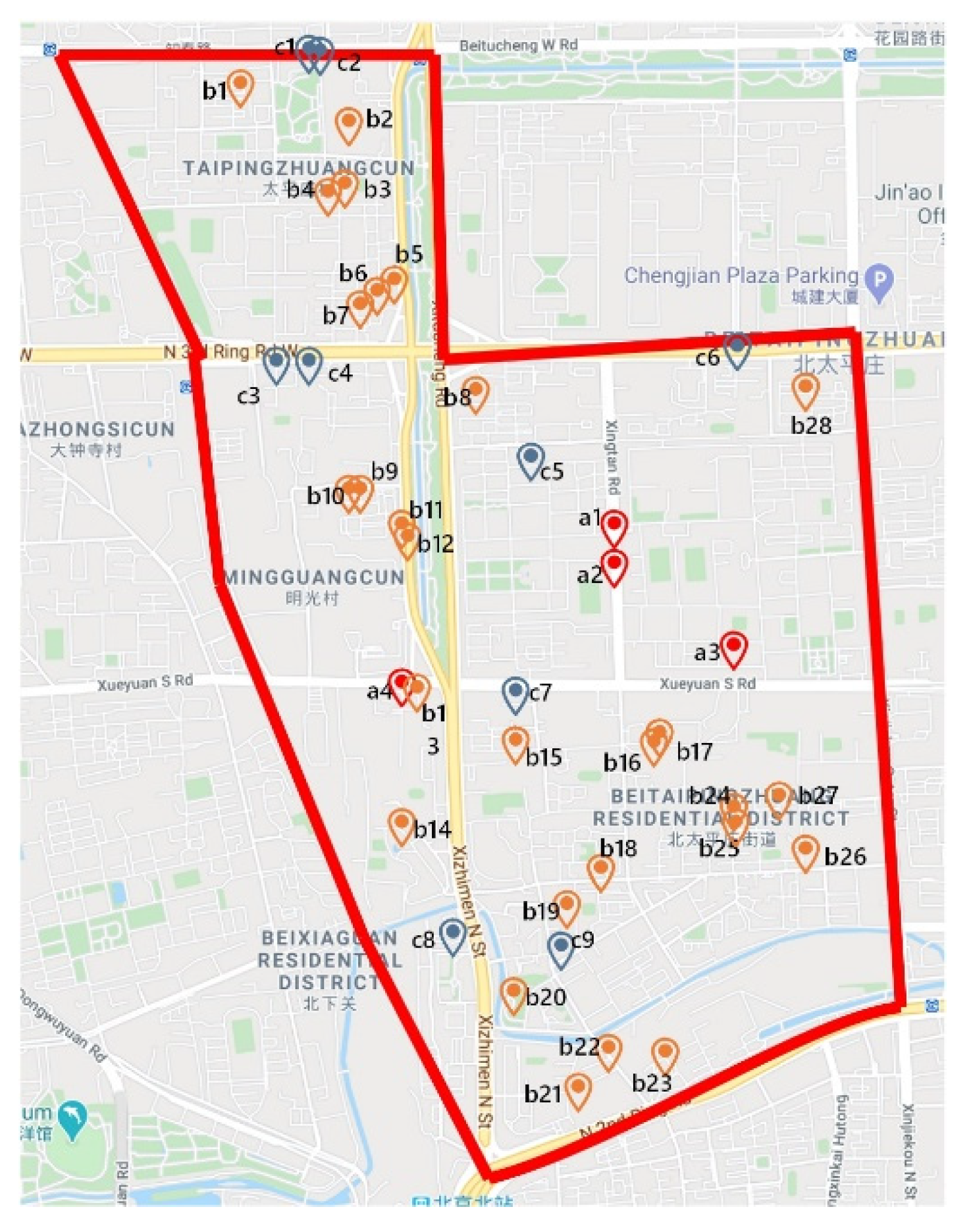
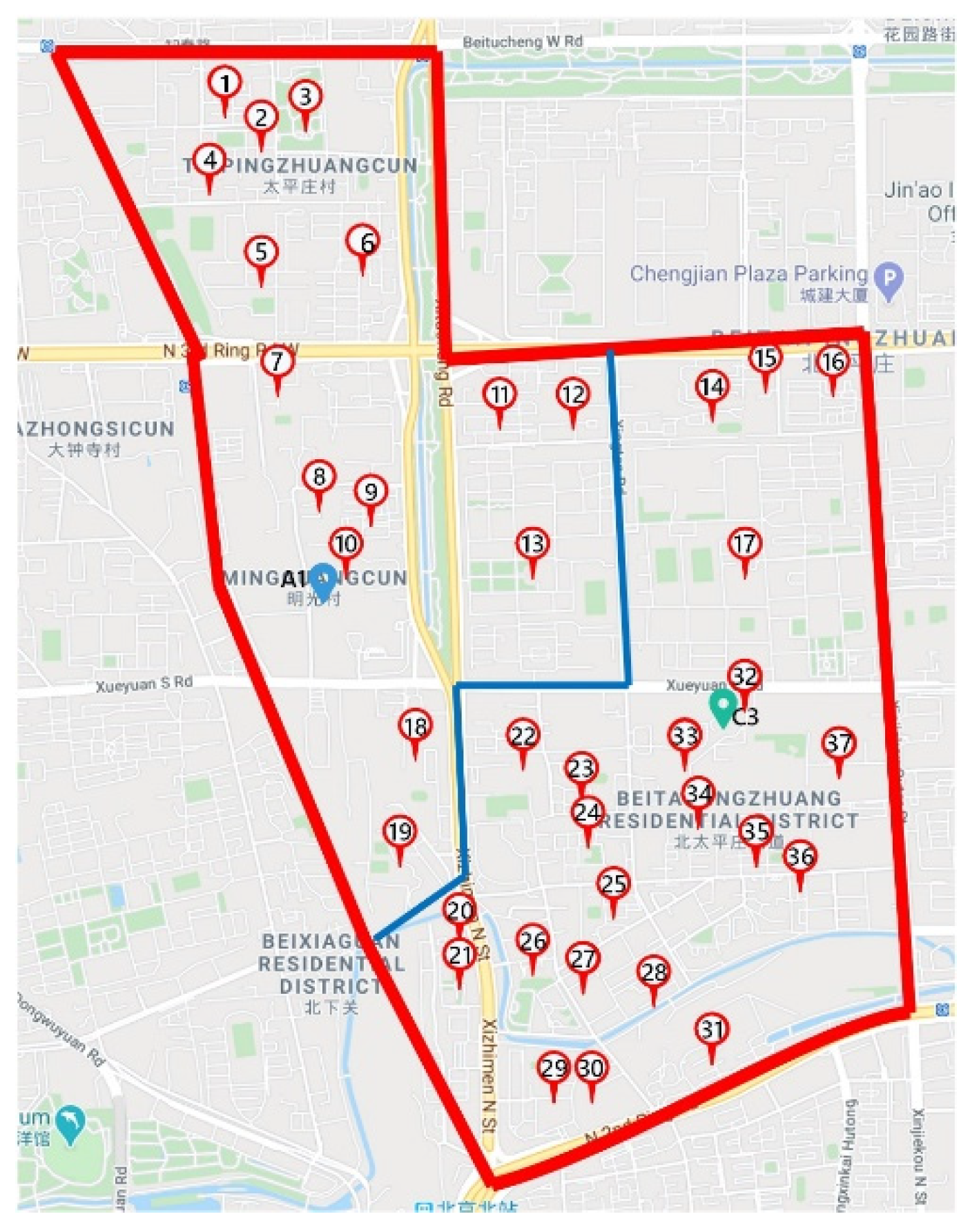
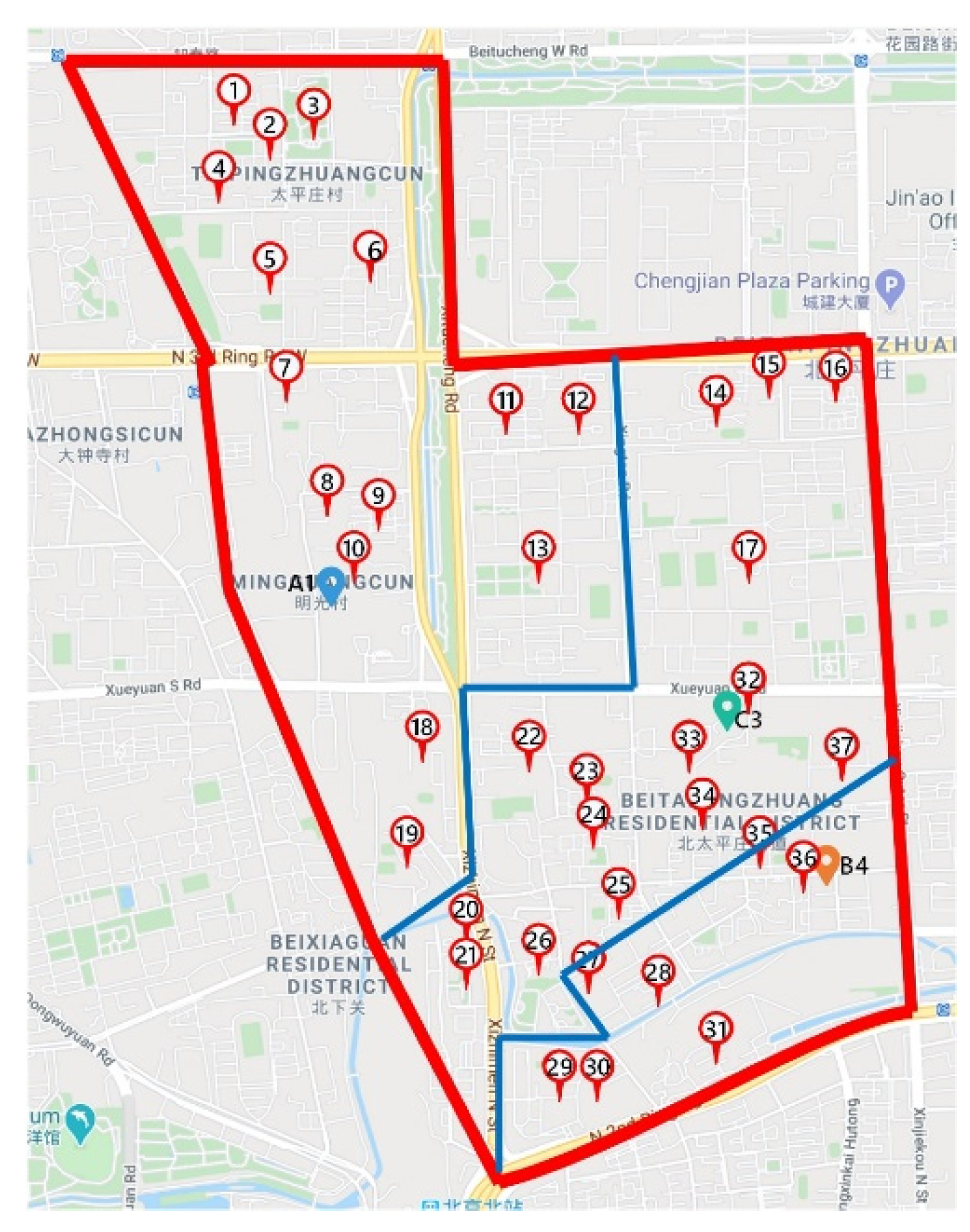
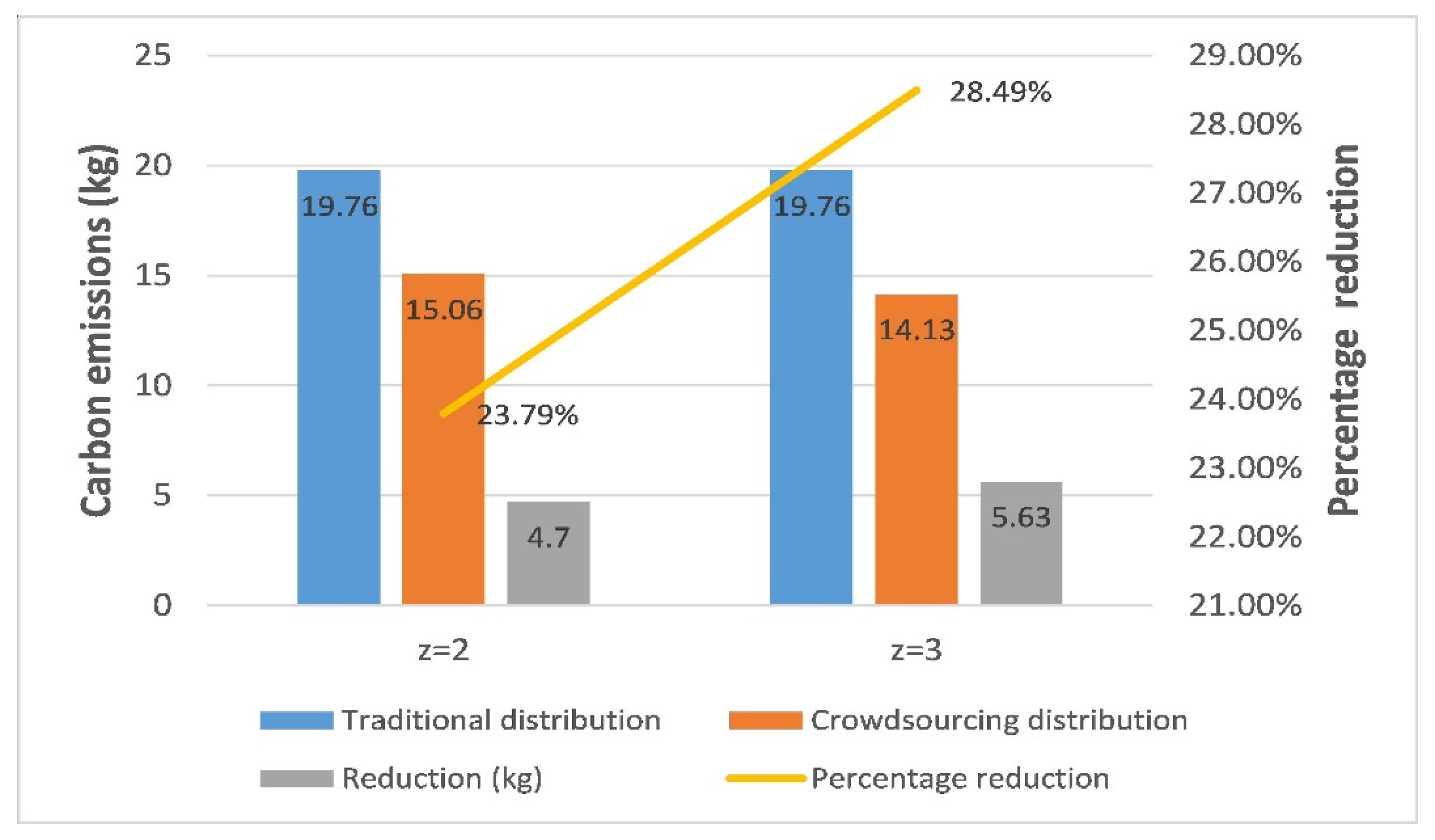

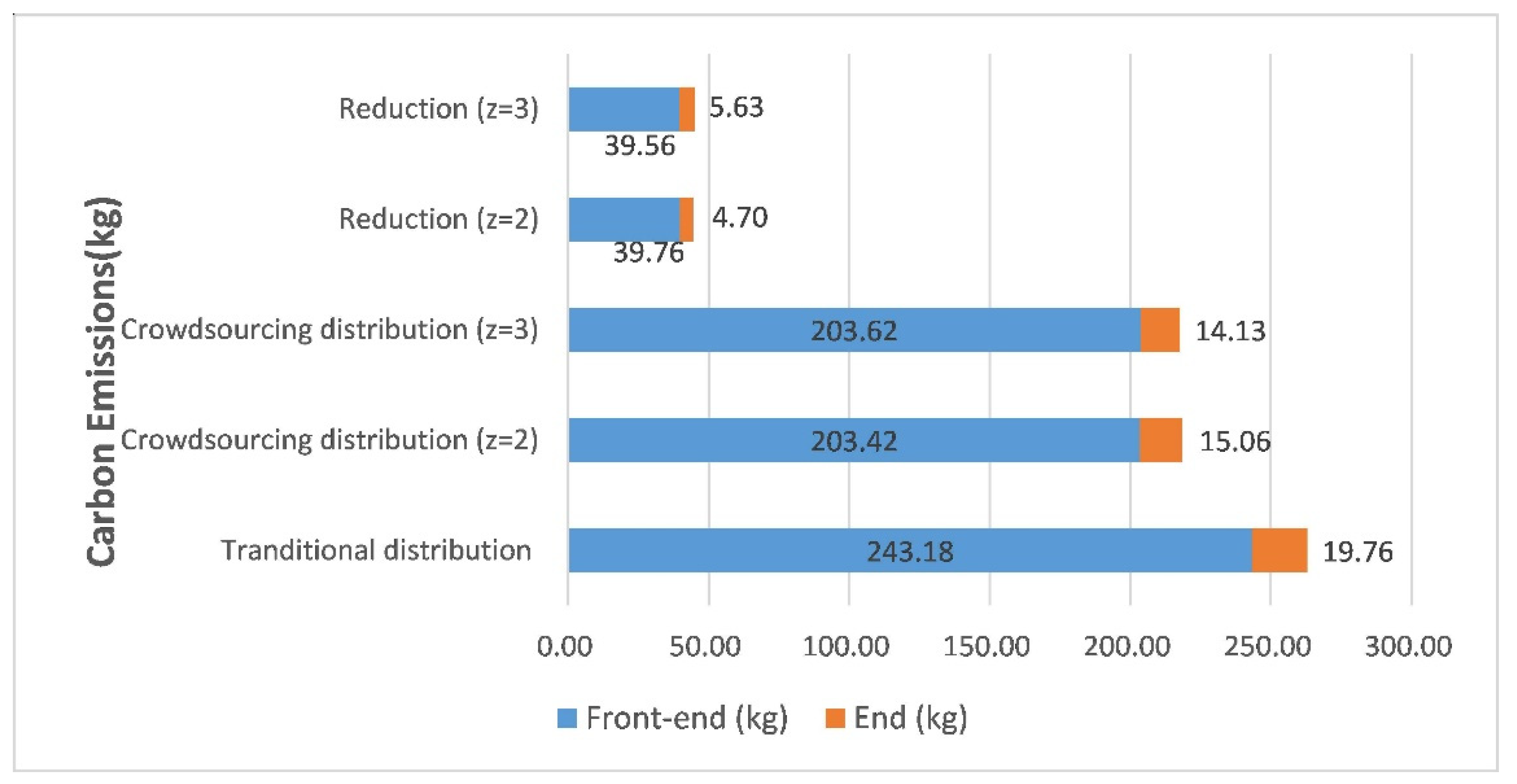
| Distribution Mode | Mode Introduction | Advantages | Limitations |
|---|---|---|---|
| Traditional mode | Couriers deliver the expresses to the customers within the agreed time. | (1) Conveniently defines the responsibility of damage and shortage. (2) Meets specific needs such as payment collection. | (1) Delivery time is uncertain. (2) Secondary delivery occurs. (3) Setting up stalls outside colleges and communities. |
| Intelligent express cabinet | Couriers temporarily store the express delivery in a cabinet, providing a 24-hour self-pickup service for customers. | (1) 24-hour self-service, no time constraints. (2) Secondary delivery reduced. (3) The responsibility for damages and shortages can be defined through monitoring equipment. | (1) High cost of construction. (2) Limited container capacity limits the size and quantity of expresses. (3) Still not close to some customers, and pickup can be inconvenient. |
| Crowdsourcing | Enterprises do not need to recruit their own express delivery teams, nor do they need to build outlets and purchase vehicles; instead, they utilize idle social manpower as couriers. | (1) Integrate idle social manpower and reduce operation costs. (2) Instant delivery can be achieved. (3) Low inventory costs from occupying minimal enterprise warehouse space. | (1) Low professional degree of couriers. (2) Difficult to ensure the personal safety and information security of customers. (3) Possible lack of manpower. (4) Difficult to determine the responsibility for package damage. |
| Third-party collection | Couriers deliver the expresses to the third-party collection point (community convenience store, property, courier station), and the customers pick up the packages themselves. | (1) No construction and operation cost. (2) Secondary delivery reduced. (3) No limit on the size and quantity of expresses because of sufficient space. | (1) Difficult to define the responsibility of damage and shortage. (2) High cost of construction. (3) Still not close to some customers, and pickup may be inconvenient. |
| j | DC | CC | BC | IKC | ||
|---|---|---|---|---|---|---|
| i | ||||||
| DC | 1 | 0 | 0 | 1 | 2 | |
| CC | 2 | 1 | 2 | 2 | 7 | |
| BC | 2 | 0 | 1 | 2 | 5 | |
| IKC | 1 | 0 | 0 | 1 | 2 | |
| Express Enterprise | DOs | EPs |
|---|---|---|
| A | A1 | 7,8,9,10,11,12,13,14,15,16,17 |
| A2 | 18,19,20,21,22,23,24,25,26,27,28,29,30,31,32,33,34,35,36,37 | |
| A3 | 1,2,3,4,5,6 | |
| B | B1 | 1,2,3,4,5,6 |
| B2 | 7,8,9,10 | |
| B3 | 18,19,20,21 | |
| B4 | 11,12,13,14,15,16,17,22,23,24,25,26,27,28,29,30,31,32,33,34,35,36,37 | |
| C | C1 | 7,8,9,10,18,19,20,21 |
| C2 | 1,2,3,4,5,6 | |
| C3 | 11,12,13,14,15,16,17 | |
| C4 | 22,23,24,25,26,27,28,29,30,31,32,33,34,35,36,37 | |
| D | D1 | 1,2,3,4,5,6 |
| D2 | 7,8,9,10,11,12,14,15,16,18,19,20,21 | |
| D3 | 13,17,22,23,24,25,26,27,28,29,30,31,32,33,34,35,36,37 |
| Express Enterprise | DOs | IECs |
|---|---|---|
| A | A1 | a1, a2, a3, b8, b9, b10, b11, b12, b28, c3, c4, c5, c6 |
| A2 | a4, b13, b14, b15, b16, b17, b18, b19, b20, b21, b22, b23, b24, b25, b26, b27, c7, c8, c9 | |
| A3 | b1, b2, b3, b4, b5, b6, b7, c1, c2 | |
| B | B1 | b1, b2, b3, b4, b5, b6, b7, c1, c2 |
| B2 | c3, c4, b9, b10, b11, b12 | |
| B3 | a4, b13, b14, c8 | |
| B4 | a1, a2, a3, b8, b15, b16, b17, b18, b19, b20, b21, b22, b23, b24, b25, b26, b27, b28, c5, c6, c7, c9 | |
| C | C1 | a4, b9, b10, b11, b12, b13, b14, c3, c4, c8 |
| C2 | b1, b2, b3, b4, b5, b6, b7, c1, c2 | |
| C3 | a1, a2, a3, b8, b28, c5, c6 | |
| C4 | b15, b16, b17, b18, b19, b20, b21, b22, b23, b24, b25, b26, b27, c7, c9 | |
| D | D1 | b1, b2, b3, b4, b5, b6, b7, c1, c2 |
| D2 | a4, b8, b9, b10, b11, b12, b13, b14, b28, c3, c4, c6, c8 | |
| D3 | a1, a2, a3, b15, b16, b17, b18, b19, b20, b21, b22, b23, b24, b25, b26, b27, c5, c7, c9 |
| Enterprise | IECs | EPs | IECs | EPs |
|---|---|---|---|---|
| a | a1 | 13,17 | ||
| a2 | 13,17 | |||
| a3 | 17,32 | |||
| a4 | 18 | |||
| b | b1 | 1,2 | b15 | 22 |
| b2 | 3 | b16 | 33 | |
| b3 | 6 | b17 | 33 | |
| b4 | 6 | b18 | 25 | |
| b5 | 6 | b19 | 25 | |
| b6 | 6 | b20 | 26 | |
| b7 | 6 | b21 | 29,30 | |
| b8 | 11 | b22 | 30 | |
| b9 | 8,9 | b23 | 31 | |
| b10 | 8,9 | b24 | 34,35 | |
| b11 | 9,10 | b25 | 35 | |
| b12 | 9,10 | b26 | 36 | |
| b13 | 18 | b27 | 35 | |
| b14 | 19 | b28 | 16 | |
| c | c1 | 3 | c6 | 15 |
| c2 | 3 | c7 | 22 | |
| c3 | 7 | c8 | 20,21 | |
| c4 | 7 | c9 | 25,26,27 | |
| c5 | 11,12,13 |
| No. | Number of Inhabitants | Average Daily Delivery Demand (Pieces) | No. | Number of Inhabitants | Average Daily Delivery Demand (Pieces) |
|---|---|---|---|---|---|
| 1 | 2219 | 646 | 20 | 2569 | 747 |
| 2 | 4844 | 1409 | 21 | 2632 | 766 |
| 3 | 2796 | 813 | 22 | 5120 | 1490 |
| 4 | 11,200 | 3259 | 23 | 2453 | 714 |
| 5 | 1450 | 422 | 24 | 7202 | 2095 |
| 6 | 12,800 | 3724 | 25 | 1775 | 516 |
| 7 | 2469 | 718 | 26 | 2633 | 766 |
| 8 | 2200 | 640 | 27 | 4717 | 1372 |
| 9 | 2454 | 714 | 28 | 6475 | 1884 |
| 10 | 894 | 260 | 29 | 1358 | 395 |
| 11 | 2249 | 654 | 30 | 1253 | 365 |
| 12 | 3277 | 953 | 31 | 3355 | 976 |
| 13 | 4929 | 1434 | 32 | 3028 | 881 |
| 14 | 1175 | 342 | 33 | 2389 | 695 |
| 15 | 2412 | 702 | 34 | 2986 | 869 |
| 16 | 2194 | 638 | 35 | 7000 | 2037 |
| 17 | 7290 | 2121 | 36 | 5313 | 1546 |
| 18 | 4800 | 1397 | 37 | 3991 | 1161 |
| 19 | 1923 | 559 |
| No. | DOs | DC | CC | BC | IKC |
|---|---|---|---|---|---|
| 1 | A1 | 0.26373626 | 0.00082940 | 0.17628058 | 12 |
| 2 | A2 | 1.08333333 | 0.00059956 | 0.30272002 | 7 |
| 3 | A3 | 0.41666667 | 0.00062508 | 0.01125763 | 4 |
| 4 | B1 | 0.41666667 | 0.00067324 | 0.01125763 | 4 |
| 5 | B2 | 0.27777778 | 0.00080110 | 0.00398860 | 12 |
| 6 | B3 | 0.22222222 | 0.00085781 | 0.00275946 | 3 |
| 7 | B4 | 1.25000000 | 0.00067300 | 0.35918194 | 9 |
| 8 | C1 | 0.50000000 | 0.00091610 | 0.06613115 | 12 |
| 9 | C2 | 0.41666667 | 0.00067479 | 0.01125763 | 4 |
| 10 | C3 | 0.38888889 | 0.00086144 | 0.01355818 | 9 |
| 11 | C4 | 0.86111111 | 0.00038074 | 0.05409035 | 7 |
| 12 | D1 | 0.41666667 | 0.00051472 | 0.01125763 | 4 |
| 13 | D2 | 0.72222222 | 0.00089098 | 0.17770136 | 12 |
| 14 | D3 | 1.02777778 | 0.00071563 | 0.13841551 | 9 |
| No. | DOs | |||
|---|---|---|---|---|
| 1 | D2 | 0.13236587 | 0.36644618 | 0.73463779 |
| 2 | A1 | 0.15128451 | 0.32720541 | 0.68382927 |
| 3 | B4 | 0.16294658 | 0.32489309 | 0.66598333 |
| 4 | C1 | 0.21088087 | 0.36358106 | 0.63290714 |
| 5 | C3 | 0.25170097 | 0.32245620 | 0.56161660 |
| 6 | A2 | 0.21679505 | 0.26235784 | 0.54754515 |
| 7 | D3 | 0.20637282 | 0.24915845 | 0.54696235 |
| 8 | B3 | 0.26561009 | 0.31802900 | 0.54490696 |
| 9 | B2 | 0.26750402 | 0.28483315 | 0.51568709 |
| 10 | C2 | 0.30053349 | 0.19647931 | 0.39532042 |
| 11 | B1 | 0.30108825 | 0.19544767 | 0.39362242 |
| 12 | A3 | 0.31950134 | 0.16343124 | 0.33841420 |
| 13 | D1 | 0.36883085 | 0.09031711 | 0.19670589 |
| 14 | C4 | 0.41834928 | 0.05504686 | 0.11628076 |
| z | ECSS | EPs |
|---|---|---|
| z = 2 | A1 | 1,2,3,4,5,6,7,8,9,10,11,12,13,18,19 |
| C3 | 14,15,16,17,20,21,22,23,24,25,26,27,28,29,30,31,32,33,34,35,36,37 | |
| z = 3 | A1 | 1,2,3,4,5,6,7,8,9,10,11,12,13,18,19 |
| C3 | 14,15,16,17,20,21,22,23,24,25,26,32,33,34,37 | |
| B4 | 27,28,29,30,31,35,36 |
| CO2 (kg) | Reduction (kg) | Percentage Reduction | |
|---|---|---|---|
| Traditional distribution | 19.76 | — | — |
| Crowdsourcing distribution (z = 2) | 15.06 | 4.7 | 23.79% |
| Crowdsourcing distribution (z = 3) | 14.13 | 5.63 | 28.49% |
| Vans | CO2 (kg) | Reduction (kg) | Percentage Reduction | |
|---|---|---|---|---|
| Traditional distribution | 31 | 243.18 | — | — |
| Crowdsourcing distribution (z = 2) | 26 | 203.42 | 39.76 | 16.35% |
| Crowdsourcing distribution (z = 3) | 26 | 203.62 | 39.56 | 16.27% |
| Number of Vans | Loading Rate | |
|---|---|---|
| Traditional distribution | 31 | 82.02% |
| Crowdsourcing distribution | 26 | 97.79% |
| Reduction | 5 | 15.77% |
| Front-End (kg) | End (kg) | Total (kg) | ||
|---|---|---|---|---|
| Traditional distribution | 243.18 | 19.76 | 262.94 | |
| Crowdsourcing distribution | z = 2 | 203.42 | 15.06 | 218.48 |
| z = 3 | 203.62 | 14.13 | 217.75 | |
| Reduction | z = 2 | 39.76 | 4.70 | 44.46 |
| z = 3 | 39.56 | 5.63 | 45.19 | |
| Percentage reduction | z = 2 | 16.35% | 23.79% | 16.91% |
| z = 3 | 16.27% | 28.49% | 17.19% | |
© 2020 by the authors. Licensee MDPI, Basel, Switzerland. This article is an open access article distributed under the terms and conditions of the Creative Commons Attribution (CC BY) license (http://creativecommons.org/licenses/by/4.0/).
Share and Cite
Bi, K.; Yang, M.; Zahid, L.; Zhou, X. A New Solution for City Distribution to Achieve Environmental Benefits within the Trend of Green Logistics: A Case Study in China. Sustainability 2020, 12, 8312. https://doi.org/10.3390/su12208312
Bi K, Yang M, Zahid L, Zhou X. A New Solution for City Distribution to Achieve Environmental Benefits within the Trend of Green Logistics: A Case Study in China. Sustainability. 2020; 12(20):8312. https://doi.org/10.3390/su12208312
Chicago/Turabian StyleBi, Kexin, Mengke Yang, Latif Zahid, and Xiaoguang Zhou. 2020. "A New Solution for City Distribution to Achieve Environmental Benefits within the Trend of Green Logistics: A Case Study in China" Sustainability 12, no. 20: 8312. https://doi.org/10.3390/su12208312





